Addressing the Theory-Practice Gap in Nursing: Strategies & Issues
VerifiedAdded on 2023/06/13
|10
|2512
|437
Essay
AI Summary
This essay examines the critical relationship between nursing theory and practice, focusing on the theory-practice gap and its implications for contemporary nursing. It uses Watson's caring theory as a framework to highlight the importance of integrating virtues like compassion, accountability, and respect into clinical practice. The essay identifies issues contributing to this gap, such as insufficient support for nursing students, lack of knowledge among educators, and excessive work pressure. Strategies to narrow the gap include increasing practical training, providing government funding for nursing research, and fostering a supportive environment for apprentice nurses. The study concludes that bridging the theory-practice gap is essential for improving the quality of care and ensuring that nursing practices align with patient needs and professional standards. Desklib offers this paper as a valuable resource for nursing students seeking to deepen their understanding of this crucial topic.
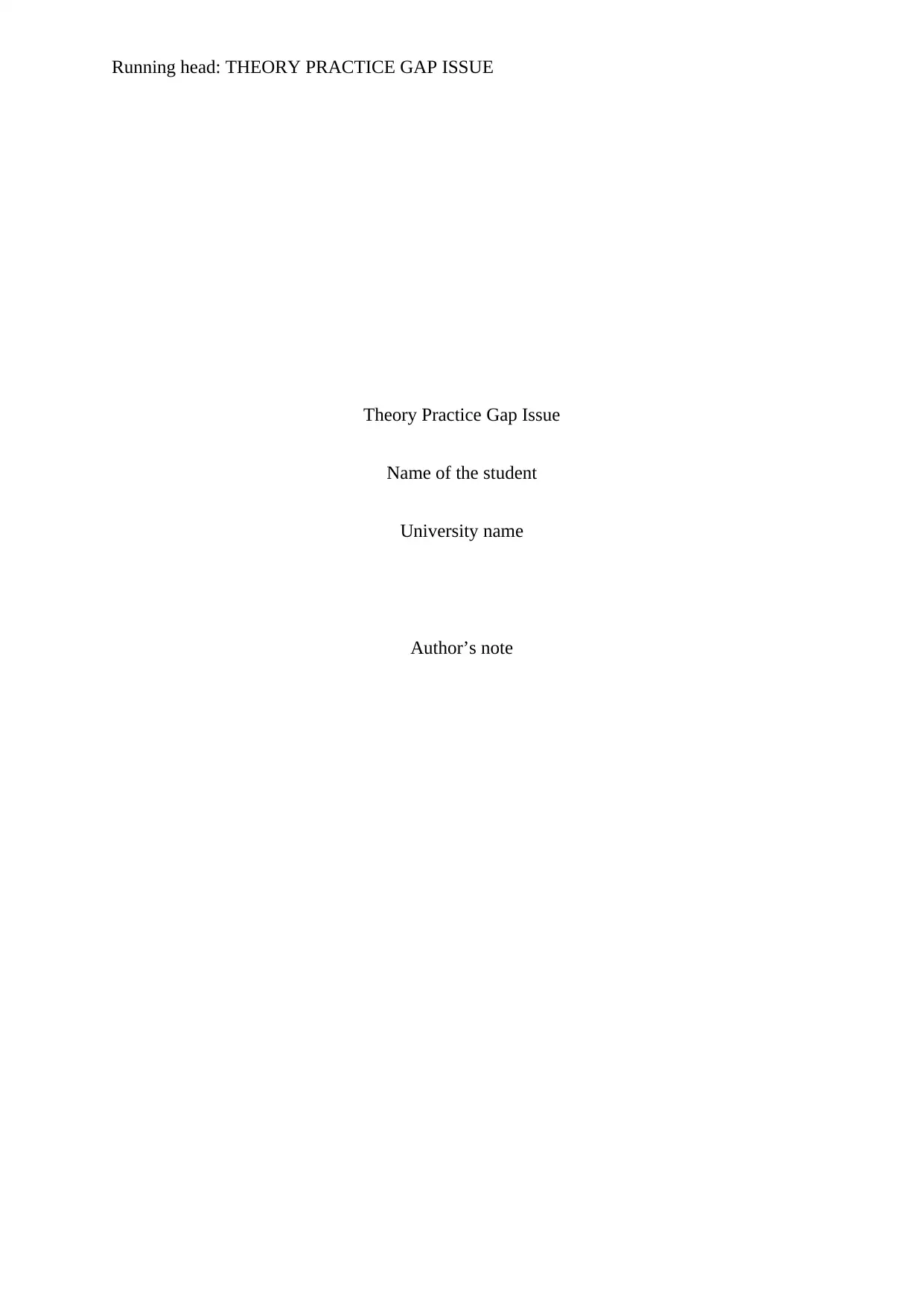
Running head: THEORY PRACTICE GAP ISSUE
Theory Practice Gap Issue
Name of the student
University name
Author’s note
Theory Practice Gap Issue
Name of the student
University name
Author’s note
Paraphrase This Document
Need a fresh take? Get an instant paraphrase of this document with our AI Paraphraser
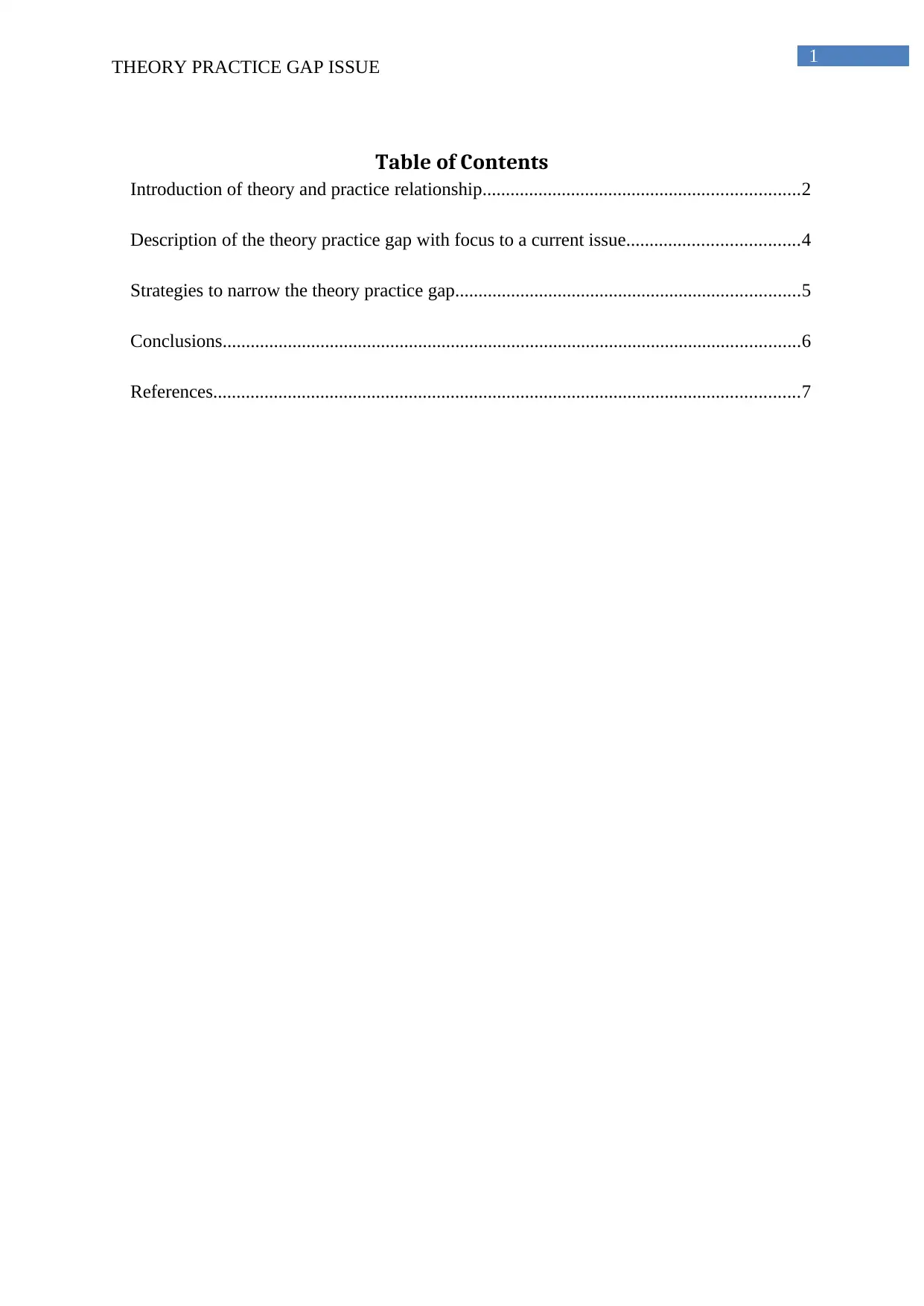
1
THEORY PRACTICE GAP ISSUE
Table of Contents
Introduction of theory and practice relationship....................................................................2
Description of the theory practice gap with focus to a current issue.....................................4
Strategies to narrow the theory practice gap..........................................................................5
Conclusions............................................................................................................................6
References..............................................................................................................................7
THEORY PRACTICE GAP ISSUE
Table of Contents
Introduction of theory and practice relationship....................................................................2
Description of the theory practice gap with focus to a current issue.....................................4
Strategies to narrow the theory practice gap..........................................................................5
Conclusions............................................................................................................................6
References..............................................................................................................................7
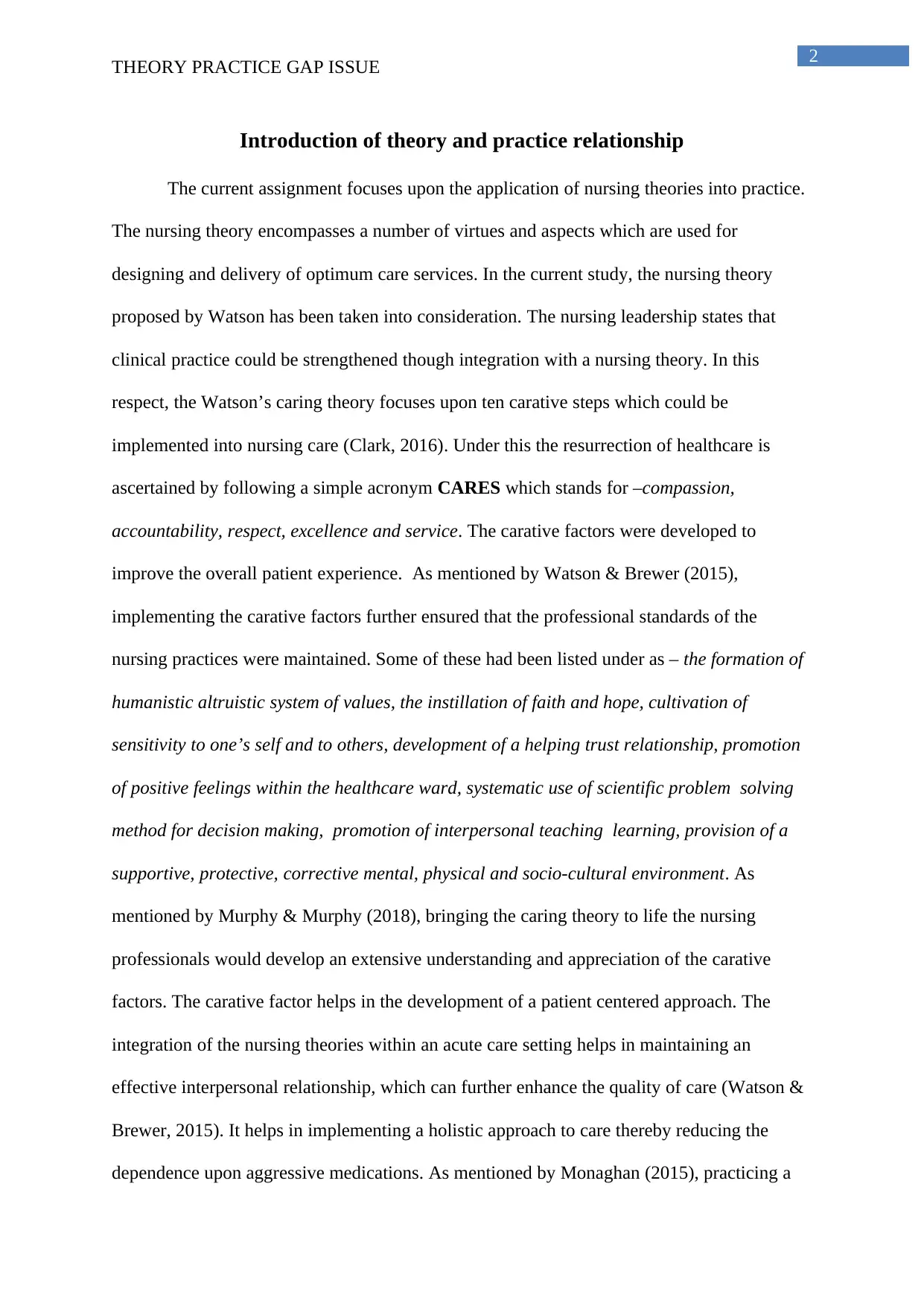
2
THEORY PRACTICE GAP ISSUE
Introduction of theory and practice relationship
The current assignment focuses upon the application of nursing theories into practice.
The nursing theory encompasses a number of virtues and aspects which are used for
designing and delivery of optimum care services. In the current study, the nursing theory
proposed by Watson has been taken into consideration. The nursing leadership states that
clinical practice could be strengthened though integration with a nursing theory. In this
respect, the Watson’s caring theory focuses upon ten carative steps which could be
implemented into nursing care (Clark, 2016). Under this the resurrection of healthcare is
ascertained by following a simple acronym CARES which stands for –compassion,
accountability, respect, excellence and service. The carative factors were developed to
improve the overall patient experience. As mentioned by Watson & Brewer (2015),
implementing the carative factors further ensured that the professional standards of the
nursing practices were maintained. Some of these had been listed under as – the formation of
humanistic altruistic system of values, the instillation of faith and hope, cultivation of
sensitivity to one’s self and to others, development of a helping trust relationship, promotion
of positive feelings within the healthcare ward, systematic use of scientific problem solving
method for decision making, promotion of interpersonal teaching learning, provision of a
supportive, protective, corrective mental, physical and socio-cultural environment. As
mentioned by Murphy & Murphy (2018), bringing the caring theory to life the nursing
professionals would develop an extensive understanding and appreciation of the carative
factors. The carative factor helps in the development of a patient centered approach. The
integration of the nursing theories within an acute care setting helps in maintaining an
effective interpersonal relationship, which can further enhance the quality of care (Watson &
Brewer, 2015). It helps in implementing a holistic approach to care thereby reducing the
dependence upon aggressive medications. As mentioned by Monaghan (2015), practicing a
THEORY PRACTICE GAP ISSUE
Introduction of theory and practice relationship
The current assignment focuses upon the application of nursing theories into practice.
The nursing theory encompasses a number of virtues and aspects which are used for
designing and delivery of optimum care services. In the current study, the nursing theory
proposed by Watson has been taken into consideration. The nursing leadership states that
clinical practice could be strengthened though integration with a nursing theory. In this
respect, the Watson’s caring theory focuses upon ten carative steps which could be
implemented into nursing care (Clark, 2016). Under this the resurrection of healthcare is
ascertained by following a simple acronym CARES which stands for –compassion,
accountability, respect, excellence and service. The carative factors were developed to
improve the overall patient experience. As mentioned by Watson & Brewer (2015),
implementing the carative factors further ensured that the professional standards of the
nursing practices were maintained. Some of these had been listed under as – the formation of
humanistic altruistic system of values, the instillation of faith and hope, cultivation of
sensitivity to one’s self and to others, development of a helping trust relationship, promotion
of positive feelings within the healthcare ward, systematic use of scientific problem solving
method for decision making, promotion of interpersonal teaching learning, provision of a
supportive, protective, corrective mental, physical and socio-cultural environment. As
mentioned by Murphy & Murphy (2018), bringing the caring theory to life the nursing
professionals would develop an extensive understanding and appreciation of the carative
factors. The carative factor helps in the development of a patient centered approach. The
integration of the nursing theories within an acute care setting helps in maintaining an
effective interpersonal relationship, which can further enhance the quality of care (Watson &
Brewer, 2015). It helps in implementing a holistic approach to care thereby reducing the
dependence upon aggressive medications. As mentioned by Monaghan (2015), practicing a
⊘ This is a preview!⊘
Do you want full access?
Subscribe today to unlock all pages.

Trusted by 1+ million students worldwide
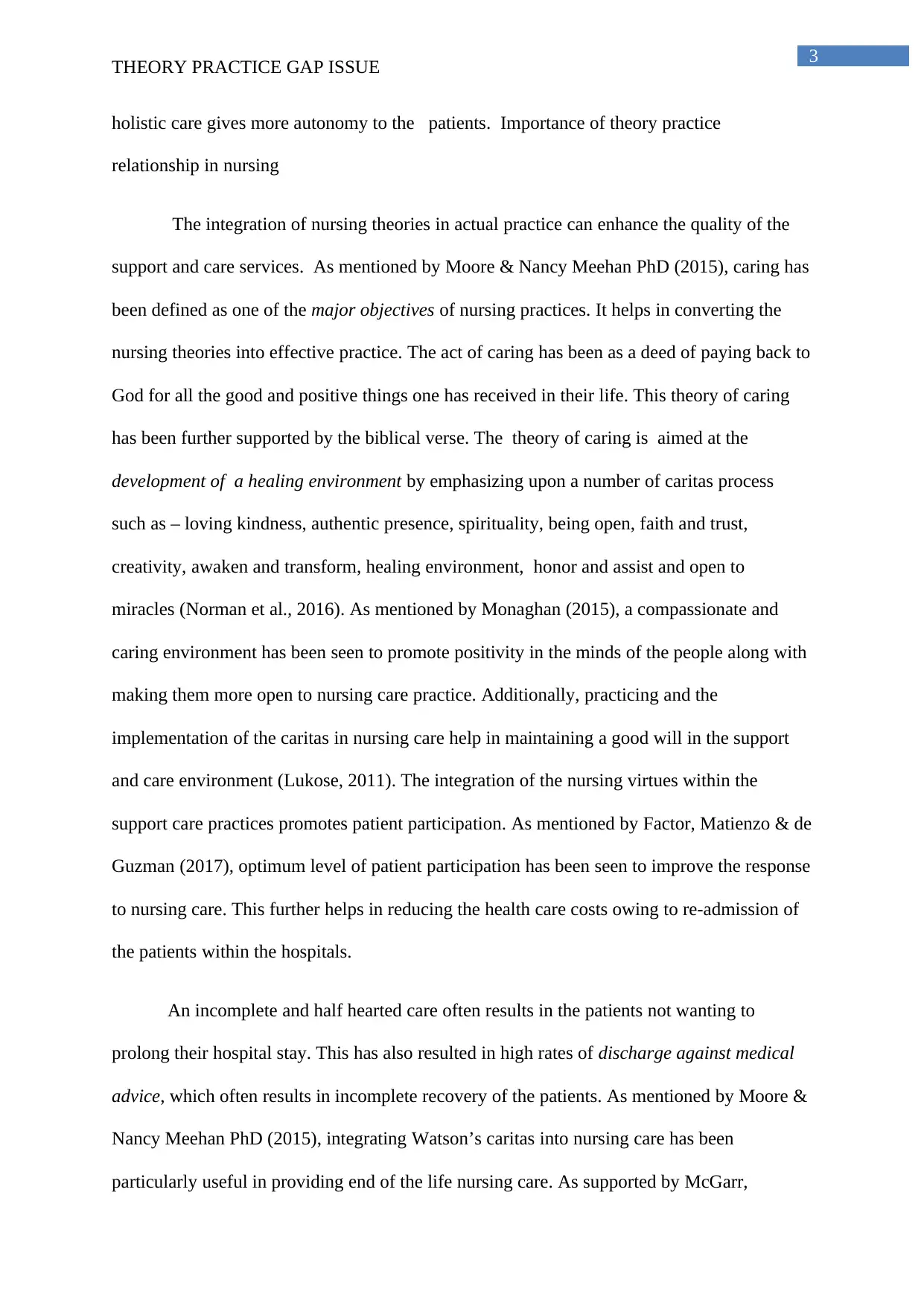
3
THEORY PRACTICE GAP ISSUE
holistic care gives more autonomy to the patients. Importance of theory practice
relationship in nursing
The integration of nursing theories in actual practice can enhance the quality of the
support and care services. As mentioned by Moore & Nancy Meehan PhD (2015), caring has
been defined as one of the major objectives of nursing practices. It helps in converting the
nursing theories into effective practice. The act of caring has been as a deed of paying back to
God for all the good and positive things one has received in their life. This theory of caring
has been further supported by the biblical verse. The theory of caring is aimed at the
development of a healing environment by emphasizing upon a number of caritas process
such as – loving kindness, authentic presence, spirituality, being open, faith and trust,
creativity, awaken and transform, healing environment, honor and assist and open to
miracles (Norman et al., 2016). As mentioned by Monaghan (2015), a compassionate and
caring environment has been seen to promote positivity in the minds of the people along with
making them more open to nursing care practice. Additionally, practicing and the
implementation of the caritas in nursing care help in maintaining a good will in the support
and care environment (Lukose, 2011). The integration of the nursing virtues within the
support care practices promotes patient participation. As mentioned by Factor, Matienzo & de
Guzman (2017), optimum level of patient participation has been seen to improve the response
to nursing care. This further helps in reducing the health care costs owing to re-admission of
the patients within the hospitals.
An incomplete and half hearted care often results in the patients not wanting to
prolong their hospital stay. This has also resulted in high rates of discharge against medical
advice, which often results in incomplete recovery of the patients. As mentioned by Moore &
Nancy Meehan PhD (2015), integrating Watson’s caritas into nursing care has been
particularly useful in providing end of the life nursing care. As supported by McGarr,
THEORY PRACTICE GAP ISSUE
holistic care gives more autonomy to the patients. Importance of theory practice
relationship in nursing
The integration of nursing theories in actual practice can enhance the quality of the
support and care services. As mentioned by Moore & Nancy Meehan PhD (2015), caring has
been defined as one of the major objectives of nursing practices. It helps in converting the
nursing theories into effective practice. The act of caring has been as a deed of paying back to
God for all the good and positive things one has received in their life. This theory of caring
has been further supported by the biblical verse. The theory of caring is aimed at the
development of a healing environment by emphasizing upon a number of caritas process
such as – loving kindness, authentic presence, spirituality, being open, faith and trust,
creativity, awaken and transform, healing environment, honor and assist and open to
miracles (Norman et al., 2016). As mentioned by Monaghan (2015), a compassionate and
caring environment has been seen to promote positivity in the minds of the people along with
making them more open to nursing care practice. Additionally, practicing and the
implementation of the caritas in nursing care help in maintaining a good will in the support
and care environment (Lukose, 2011). The integration of the nursing virtues within the
support care practices promotes patient participation. As mentioned by Factor, Matienzo & de
Guzman (2017), optimum level of patient participation has been seen to improve the response
to nursing care. This further helps in reducing the health care costs owing to re-admission of
the patients within the hospitals.
An incomplete and half hearted care often results in the patients not wanting to
prolong their hospital stay. This has also resulted in high rates of discharge against medical
advice, which often results in incomplete recovery of the patients. As mentioned by Moore &
Nancy Meehan PhD (2015), integrating Watson’s caritas into nursing care has been
particularly useful in providing end of the life nursing care. As supported by McGarr,
Paraphrase This Document
Need a fresh take? Get an instant paraphrase of this document with our AI Paraphraser

4
THEORY PRACTICE GAP ISSUE
O’Grady & Guilfoyle (2017), practicing the nursing theories in accrual clinical setup can
favor the growth and development of a highly optimistic environment. It helps in
supporting one’s deep beliefs by providing them the maximum space to integrate their desires
and wishes s into healthcare decision making.
The benefits of the implementation of the nursing theories into actual clinical practice
could be discussed over here with respect to the financial costs. The increased patient and
staff member satisfaction has led to 31% cutting to the additional costs generated annually.
Additionally, provision of additional benefits to the hospital staffs such as compassionate
care award under which each staff received coupon worth $75 in their favorite restaurants
could encourage the staffs to perform better (Huston et al., 2018). As mentioned by McGarr,
O’Grady & Guilfoyle (2017), such small acts help in motivating the workforce to perform
better. This falls in line with the caritas of love and kindness as per the Watson’s objectives.
Description of the theory practice gap with focus to a current issue
There are a number of factors which are responsible for creating a gap between
nursing theories and professional practice. Some of these service gaps could be discussed
over here which further affects the quality and standards of care. As mentioned by Saifan,
AbuRuz & Masa'deh (2015), lacunae present within the apprenticeship model where the
nursing students fail to receive sufficient support and care from their mentors’ further lead to
a gap in their understanding of care. The nursing students are used as support care providers
in the emergency care wards of certain hospitals. Hence, they lack the required expertise and
knowledge, which further deteriorates the quality of the care services. As mentioned by
Jairath et al. (2018), lack of effective knowledge regarding current clinical practices within
the nursing educators could be a hindrance in the implementation of effective nursing care
practices. The contemporary health care scenario places much importance upon the
THEORY PRACTICE GAP ISSUE
O’Grady & Guilfoyle (2017), practicing the nursing theories in accrual clinical setup can
favor the growth and development of a highly optimistic environment. It helps in
supporting one’s deep beliefs by providing them the maximum space to integrate their desires
and wishes s into healthcare decision making.
The benefits of the implementation of the nursing theories into actual clinical practice
could be discussed over here with respect to the financial costs. The increased patient and
staff member satisfaction has led to 31% cutting to the additional costs generated annually.
Additionally, provision of additional benefits to the hospital staffs such as compassionate
care award under which each staff received coupon worth $75 in their favorite restaurants
could encourage the staffs to perform better (Huston et al., 2018). As mentioned by McGarr,
O’Grady & Guilfoyle (2017), such small acts help in motivating the workforce to perform
better. This falls in line with the caritas of love and kindness as per the Watson’s objectives.
Description of the theory practice gap with focus to a current issue
There are a number of factors which are responsible for creating a gap between
nursing theories and professional practice. Some of these service gaps could be discussed
over here which further affects the quality and standards of care. As mentioned by Saifan,
AbuRuz & Masa'deh (2015), lacunae present within the apprenticeship model where the
nursing students fail to receive sufficient support and care from their mentors’ further lead to
a gap in their understanding of care. The nursing students are used as support care providers
in the emergency care wards of certain hospitals. Hence, they lack the required expertise and
knowledge, which further deteriorates the quality of the care services. As mentioned by
Jairath et al. (2018), lack of effective knowledge regarding current clinical practices within
the nursing educators could be a hindrance in the implementation of effective nursing care
practices. The contemporary health care scenario places much importance upon the
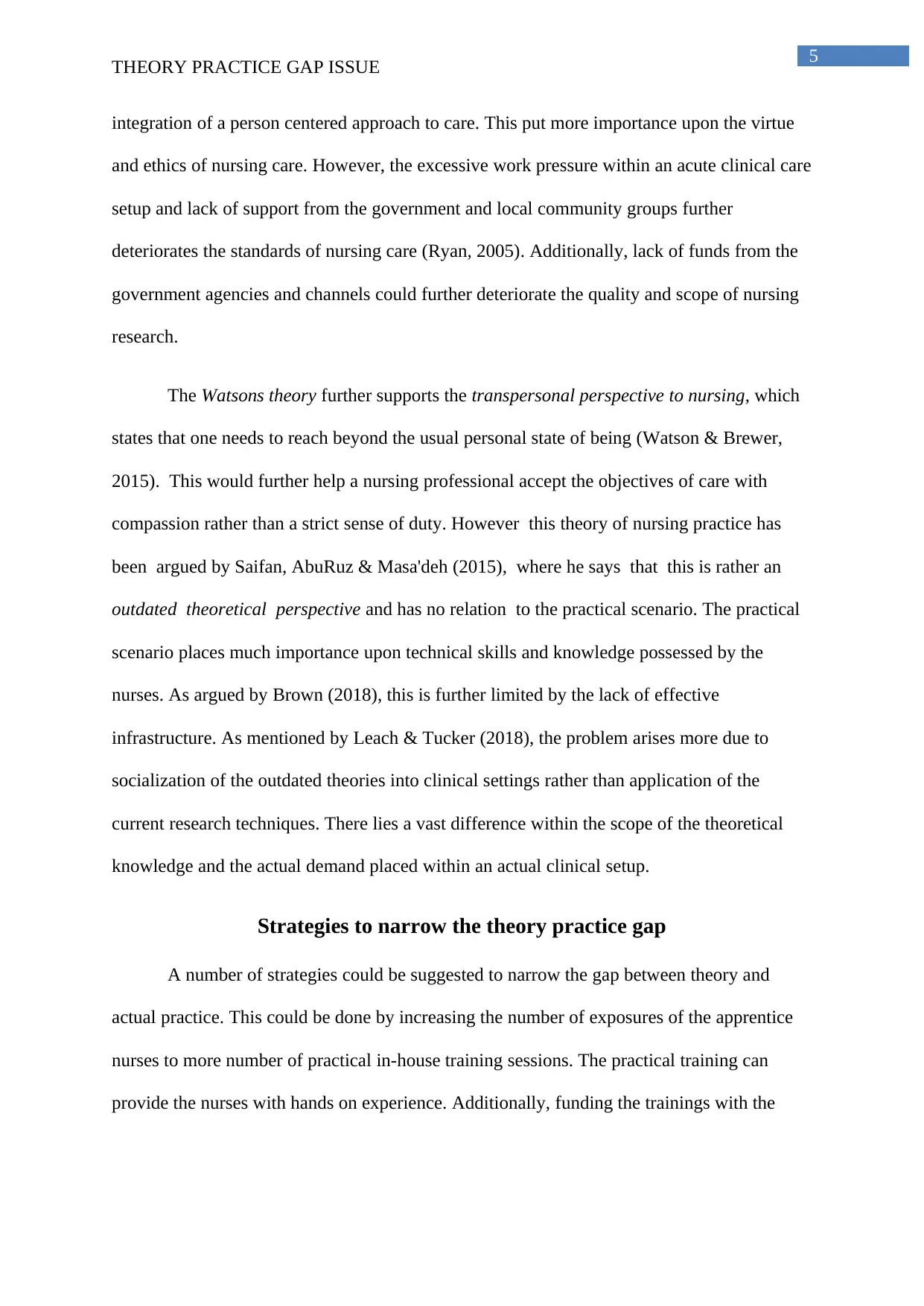
5
THEORY PRACTICE GAP ISSUE
integration of a person centered approach to care. This put more importance upon the virtue
and ethics of nursing care. However, the excessive work pressure within an acute clinical care
setup and lack of support from the government and local community groups further
deteriorates the standards of nursing care (Ryan, 2005). Additionally, lack of funds from the
government agencies and channels could further deteriorate the quality and scope of nursing
research.
The Watsons theory further supports the transpersonal perspective to nursing, which
states that one needs to reach beyond the usual personal state of being (Watson & Brewer,
2015). This would further help a nursing professional accept the objectives of care with
compassion rather than a strict sense of duty. However this theory of nursing practice has
been argued by Saifan, AbuRuz & Masa'deh (2015), where he says that this is rather an
outdated theoretical perspective and has no relation to the practical scenario. The practical
scenario places much importance upon technical skills and knowledge possessed by the
nurses. As argued by Brown (2018), this is further limited by the lack of effective
infrastructure. As mentioned by Leach & Tucker (2018), the problem arises more due to
socialization of the outdated theories into clinical settings rather than application of the
current research techniques. There lies a vast difference within the scope of the theoretical
knowledge and the actual demand placed within an actual clinical setup.
Strategies to narrow the theory practice gap
A number of strategies could be suggested to narrow the gap between theory and
actual practice. This could be done by increasing the number of exposures of the apprentice
nurses to more number of practical in-house training sessions. The practical training can
provide the nurses with hands on experience. Additionally, funding the trainings with the
THEORY PRACTICE GAP ISSUE
integration of a person centered approach to care. This put more importance upon the virtue
and ethics of nursing care. However, the excessive work pressure within an acute clinical care
setup and lack of support from the government and local community groups further
deteriorates the standards of nursing care (Ryan, 2005). Additionally, lack of funds from the
government agencies and channels could further deteriorate the quality and scope of nursing
research.
The Watsons theory further supports the transpersonal perspective to nursing, which
states that one needs to reach beyond the usual personal state of being (Watson & Brewer,
2015). This would further help a nursing professional accept the objectives of care with
compassion rather than a strict sense of duty. However this theory of nursing practice has
been argued by Saifan, AbuRuz & Masa'deh (2015), where he says that this is rather an
outdated theoretical perspective and has no relation to the practical scenario. The practical
scenario places much importance upon technical skills and knowledge possessed by the
nurses. As argued by Brown (2018), this is further limited by the lack of effective
infrastructure. As mentioned by Leach & Tucker (2018), the problem arises more due to
socialization of the outdated theories into clinical settings rather than application of the
current research techniques. There lies a vast difference within the scope of the theoretical
knowledge and the actual demand placed within an actual clinical setup.
Strategies to narrow the theory practice gap
A number of strategies could be suggested to narrow the gap between theory and
actual practice. This could be done by increasing the number of exposures of the apprentice
nurses to more number of practical in-house training sessions. The practical training can
provide the nurses with hands on experience. Additionally, funding the trainings with the
⊘ This is a preview!⊘
Do you want full access?
Subscribe today to unlock all pages.

Trusted by 1+ million students worldwide
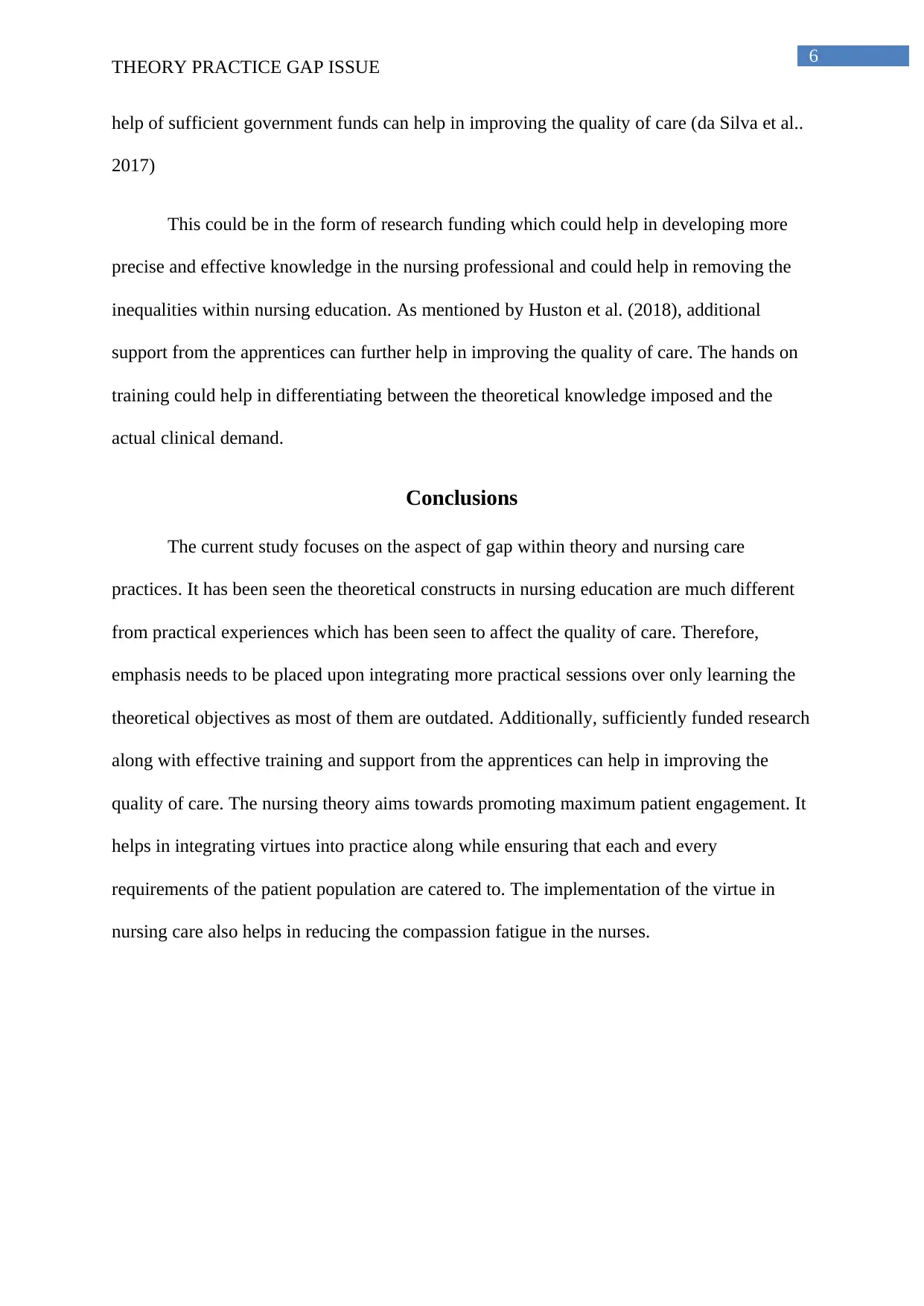
6
THEORY PRACTICE GAP ISSUE
help of sufficient government funds can help in improving the quality of care (da Silva et al..
2017)
This could be in the form of research funding which could help in developing more
precise and effective knowledge in the nursing professional and could help in removing the
inequalities within nursing education. As mentioned by Huston et al. (2018), additional
support from the apprentices can further help in improving the quality of care. The hands on
training could help in differentiating between the theoretical knowledge imposed and the
actual clinical demand.
Conclusions
The current study focuses on the aspect of gap within theory and nursing care
practices. It has been seen the theoretical constructs in nursing education are much different
from practical experiences which has been seen to affect the quality of care. Therefore,
emphasis needs to be placed upon integrating more practical sessions over only learning the
theoretical objectives as most of them are outdated. Additionally, sufficiently funded research
along with effective training and support from the apprentices can help in improving the
quality of care. The nursing theory aims towards promoting maximum patient engagement. It
helps in integrating virtues into practice along while ensuring that each and every
requirements of the patient population are catered to. The implementation of the virtue in
nursing care also helps in reducing the compassion fatigue in the nurses.
THEORY PRACTICE GAP ISSUE
help of sufficient government funds can help in improving the quality of care (da Silva et al..
2017)
This could be in the form of research funding which could help in developing more
precise and effective knowledge in the nursing professional and could help in removing the
inequalities within nursing education. As mentioned by Huston et al. (2018), additional
support from the apprentices can further help in improving the quality of care. The hands on
training could help in differentiating between the theoretical knowledge imposed and the
actual clinical demand.
Conclusions
The current study focuses on the aspect of gap within theory and nursing care
practices. It has been seen the theoretical constructs in nursing education are much different
from practical experiences which has been seen to affect the quality of care. Therefore,
emphasis needs to be placed upon integrating more practical sessions over only learning the
theoretical objectives as most of them are outdated. Additionally, sufficiently funded research
along with effective training and support from the apprentices can help in improving the
quality of care. The nursing theory aims towards promoting maximum patient engagement. It
helps in integrating virtues into practice along while ensuring that each and every
requirements of the patient population are catered to. The implementation of the virtue in
nursing care also helps in reducing the compassion fatigue in the nurses.
Paraphrase This Document
Need a fresh take? Get an instant paraphrase of this document with our AI Paraphraser
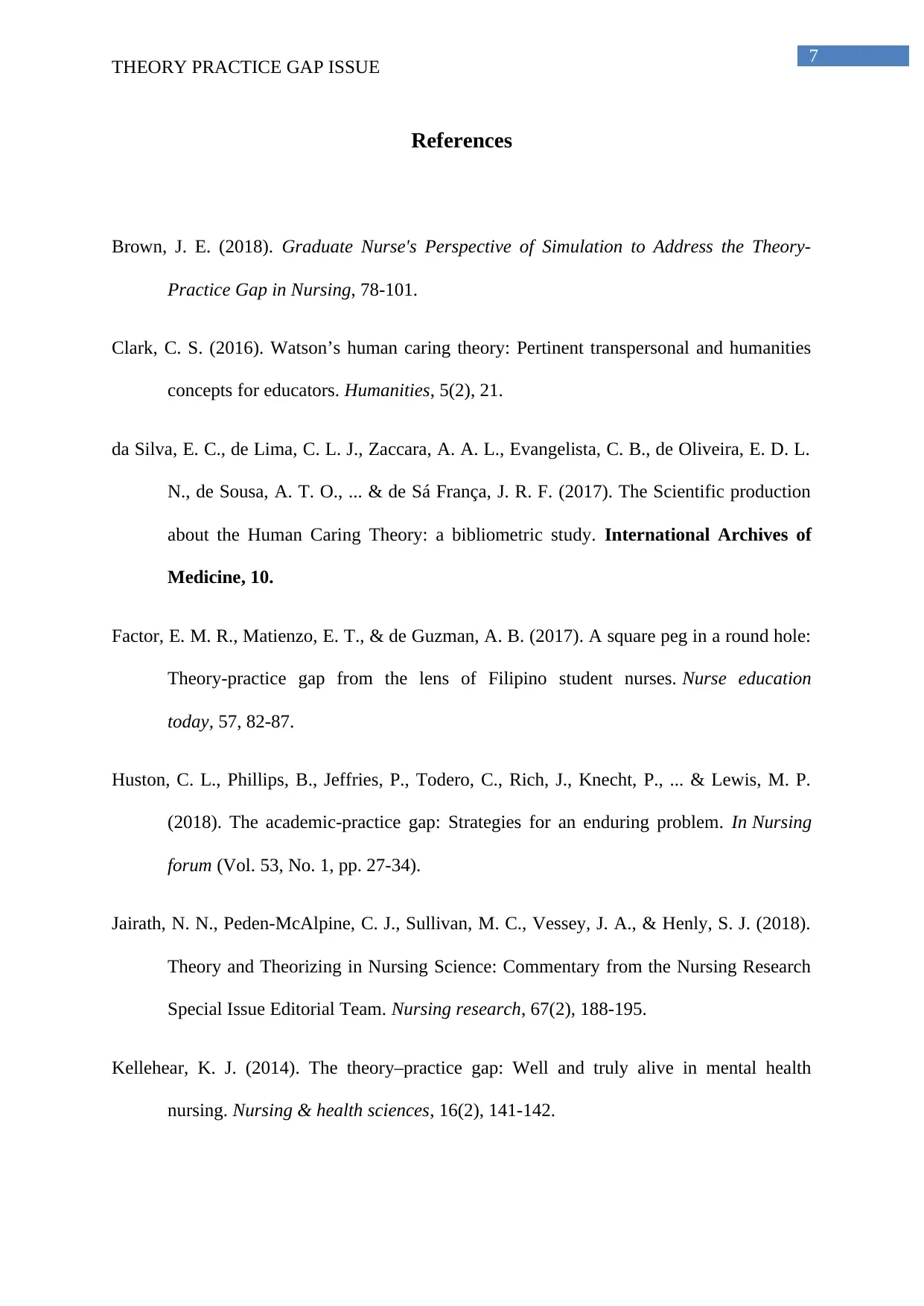
7
THEORY PRACTICE GAP ISSUE
References
Brown, J. E. (2018). Graduate Nurse's Perspective of Simulation to Address the Theory-
Practice Gap in Nursing, 78-101.
Clark, C. S. (2016). Watson’s human caring theory: Pertinent transpersonal and humanities
concepts for educators. Humanities, 5(2), 21.
da Silva, E. C., de Lima, C. L. J., Zaccara, A. A. L., Evangelista, C. B., de Oliveira, E. D. L.
N., de Sousa, A. T. O., ... & de Sá França, J. R. F. (2017). The Scientific production
about the Human Caring Theory: a bibliometric study. International Archives of
Medicine, 10.
Factor, E. M. R., Matienzo, E. T., & de Guzman, A. B. (2017). A square peg in a round hole:
Theory-practice gap from the lens of Filipino student nurses. Nurse education
today, 57, 82-87.
Huston, C. L., Phillips, B., Jeffries, P., Todero, C., Rich, J., Knecht, P., ... & Lewis, M. P.
(2018). The academic‐practice gap: Strategies for an enduring problem. In Nursing
forum (Vol. 53, No. 1, pp. 27-34).
Jairath, N. N., Peden-McAlpine, C. J., Sullivan, M. C., Vessey, J. A., & Henly, S. J. (2018).
Theory and Theorizing in Nursing Science: Commentary from the Nursing Research
Special Issue Editorial Team. Nursing research, 67(2), 188-195.
Kellehear, K. J. (2014). The theory–practice gap: Well and truly alive in mental health
nursing. Nursing & health sciences, 16(2), 141-142.
THEORY PRACTICE GAP ISSUE
References
Brown, J. E. (2018). Graduate Nurse's Perspective of Simulation to Address the Theory-
Practice Gap in Nursing, 78-101.
Clark, C. S. (2016). Watson’s human caring theory: Pertinent transpersonal and humanities
concepts for educators. Humanities, 5(2), 21.
da Silva, E. C., de Lima, C. L. J., Zaccara, A. A. L., Evangelista, C. B., de Oliveira, E. D. L.
N., de Sousa, A. T. O., ... & de Sá França, J. R. F. (2017). The Scientific production
about the Human Caring Theory: a bibliometric study. International Archives of
Medicine, 10.
Factor, E. M. R., Matienzo, E. T., & de Guzman, A. B. (2017). A square peg in a round hole:
Theory-practice gap from the lens of Filipino student nurses. Nurse education
today, 57, 82-87.
Huston, C. L., Phillips, B., Jeffries, P., Todero, C., Rich, J., Knecht, P., ... & Lewis, M. P.
(2018). The academic‐practice gap: Strategies for an enduring problem. In Nursing
forum (Vol. 53, No. 1, pp. 27-34).
Jairath, N. N., Peden-McAlpine, C. J., Sullivan, M. C., Vessey, J. A., & Henly, S. J. (2018).
Theory and Theorizing in Nursing Science: Commentary from the Nursing Research
Special Issue Editorial Team. Nursing research, 67(2), 188-195.
Kellehear, K. J. (2014). The theory–practice gap: Well and truly alive in mental health
nursing. Nursing & health sciences, 16(2), 141-142.
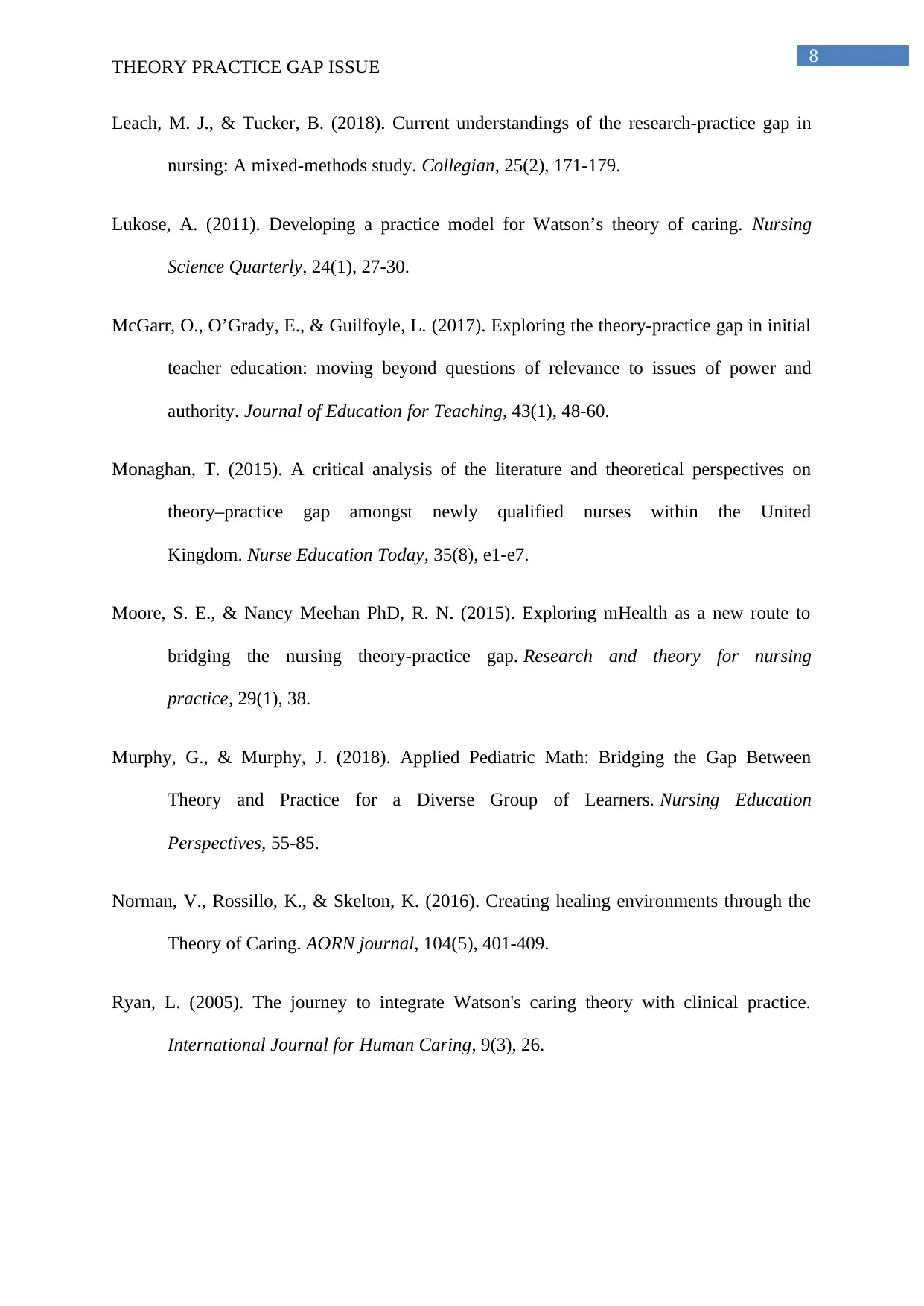
8
THEORY PRACTICE GAP ISSUE
Leach, M. J., & Tucker, B. (2018). Current understandings of the research-practice gap in
nursing: A mixed-methods study. Collegian, 25(2), 171-179.
Lukose, A. (2011). Developing a practice model for Watson’s theory of caring. Nursing
Science Quarterly, 24(1), 27-30.
McGarr, O., O’Grady, E., & Guilfoyle, L. (2017). Exploring the theory-practice gap in initial
teacher education: moving beyond questions of relevance to issues of power and
authority. Journal of Education for Teaching, 43(1), 48-60.
Monaghan, T. (2015). A critical analysis of the literature and theoretical perspectives on
theory–practice gap amongst newly qualified nurses within the United
Kingdom. Nurse Education Today, 35(8), e1-e7.
Moore, S. E., & Nancy Meehan PhD, R. N. (2015). Exploring mHealth as a new route to
bridging the nursing theory-practice gap. Research and theory for nursing
practice, 29(1), 38.
Murphy, G., & Murphy, J. (2018). Applied Pediatric Math: Bridging the Gap Between
Theory and Practice for a Diverse Group of Learners. Nursing Education
Perspectives, 55-85.
Norman, V., Rossillo, K., & Skelton, K. (2016). Creating healing environments through the
Theory of Caring. AORN journal, 104(5), 401-409.
Ryan, L. (2005). The journey to integrate Watson's caring theory with clinical practice.
International Journal for Human Caring, 9(3), 26.
THEORY PRACTICE GAP ISSUE
Leach, M. J., & Tucker, B. (2018). Current understandings of the research-practice gap in
nursing: A mixed-methods study. Collegian, 25(2), 171-179.
Lukose, A. (2011). Developing a practice model for Watson’s theory of caring. Nursing
Science Quarterly, 24(1), 27-30.
McGarr, O., O’Grady, E., & Guilfoyle, L. (2017). Exploring the theory-practice gap in initial
teacher education: moving beyond questions of relevance to issues of power and
authority. Journal of Education for Teaching, 43(1), 48-60.
Monaghan, T. (2015). A critical analysis of the literature and theoretical perspectives on
theory–practice gap amongst newly qualified nurses within the United
Kingdom. Nurse Education Today, 35(8), e1-e7.
Moore, S. E., & Nancy Meehan PhD, R. N. (2015). Exploring mHealth as a new route to
bridging the nursing theory-practice gap. Research and theory for nursing
practice, 29(1), 38.
Murphy, G., & Murphy, J. (2018). Applied Pediatric Math: Bridging the Gap Between
Theory and Practice for a Diverse Group of Learners. Nursing Education
Perspectives, 55-85.
Norman, V., Rossillo, K., & Skelton, K. (2016). Creating healing environments through the
Theory of Caring. AORN journal, 104(5), 401-409.
Ryan, L. (2005). The journey to integrate Watson's caring theory with clinical practice.
International Journal for Human Caring, 9(3), 26.
⊘ This is a preview!⊘
Do you want full access?
Subscribe today to unlock all pages.

Trusted by 1+ million students worldwide
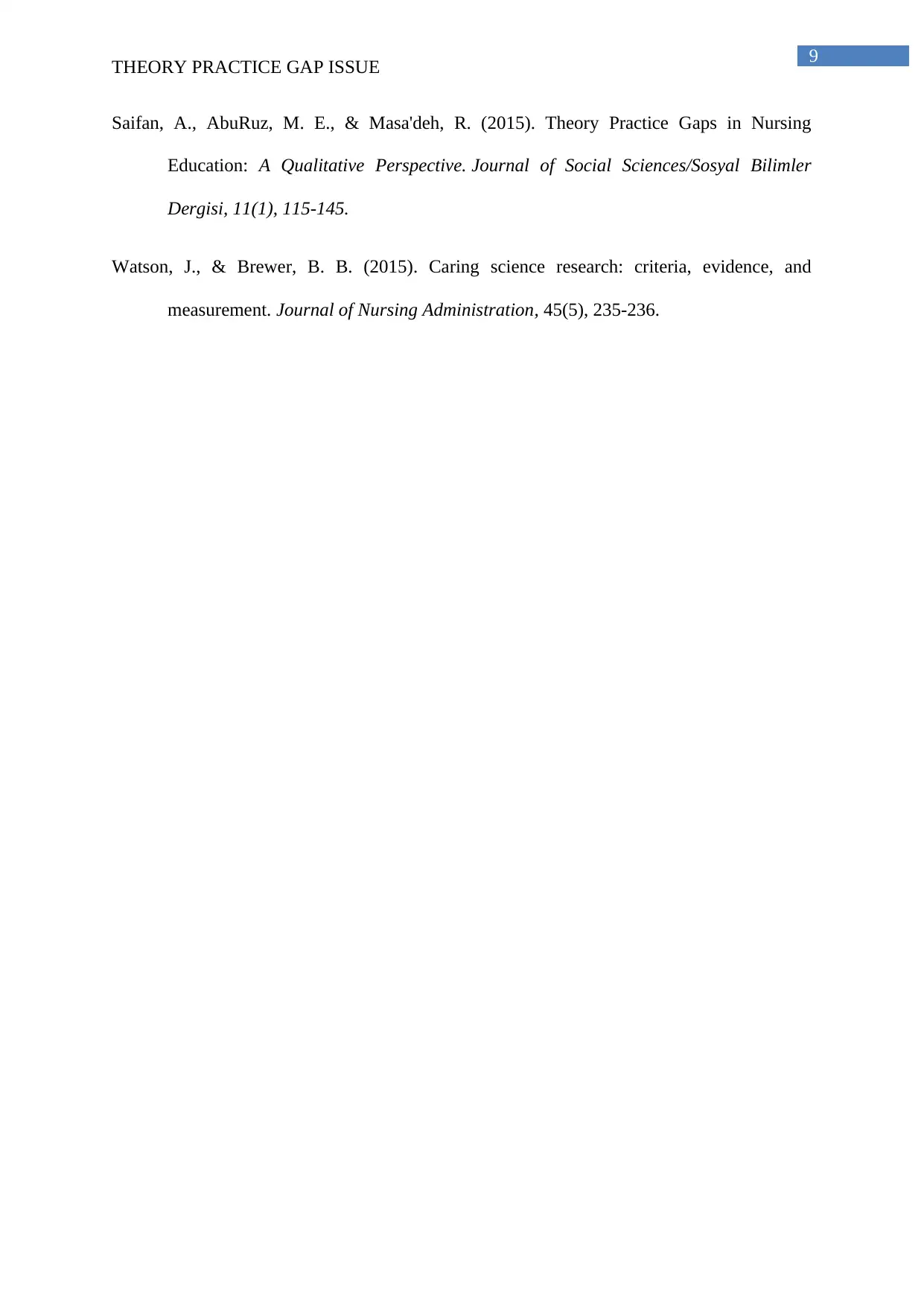
9
THEORY PRACTICE GAP ISSUE
Saifan, A., AbuRuz, M. E., & Masa'deh, R. (2015). Theory Practice Gaps in Nursing
Education: A Qualitative Perspective. Journal of Social Sciences/Sosyal Bilimler
Dergisi, 11(1), 115-145.
Watson, J., & Brewer, B. B. (2015). Caring science research: criteria, evidence, and
measurement. Journal of Nursing Administration, 45(5), 235-236.
THEORY PRACTICE GAP ISSUE
Saifan, A., AbuRuz, M. E., & Masa'deh, R. (2015). Theory Practice Gaps in Nursing
Education: A Qualitative Perspective. Journal of Social Sciences/Sosyal Bilimler
Dergisi, 11(1), 115-145.
Watson, J., & Brewer, B. B. (2015). Caring science research: criteria, evidence, and
measurement. Journal of Nursing Administration, 45(5), 235-236.
1 out of 10
Related Documents
Your All-in-One AI-Powered Toolkit for Academic Success.
+13062052269
info@desklib.com
Available 24*7 on WhatsApp / Email
![[object Object]](/_next/static/media/star-bottom.7253800d.svg)
Unlock your academic potential
Copyright © 2020–2025 A2Z Services. All Rights Reserved. Developed and managed by ZUCOL.





